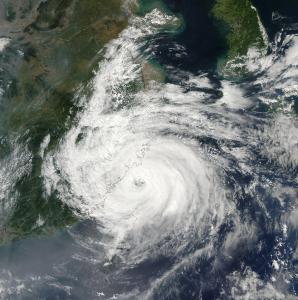La Nina-like ocean cooling patterns intensify tropical cyclones
University of Hawaiʻi at MānoaThe intensity and frequency of strong tropical cyclones, as well as cyclone landfalls, have increased in recent decades in the northwestern Pacific Ocean, raising speculation about the root cause of the surge in destructive Category 4 and 5 storms.
Now atmospheric researchers at the University of Hawaiʻi at Mānoa‘s International Pacific Research Center (IPRC) have published a study in Scientific Reports showing a strong connection between sea surface temperature patterns associated with the Global Warming Hiatus phenomenon and changes in cyclone activity over the northwest Pacific Ocean, particularly increasing intensities in coastal regions of East Asia.
Climate change has been marked by a persistent, if uneven, increase in global temperatures through time.
Around the turn of the century, 1998-2012, the rate of temperature increase apparently slowed, and has since been labeled the Global Warming Hiatus. During this period, while the Indian and tropical north Atlantic Oceans warmed, the tropical eastern Pacific Ocean experienced La Niña-like cooling.
La Niña is usually characterized by cooler sea surface temperatures in the eastern and central Pacific, pushing cyclone generation westward.
IPRC researchers Yuqing Wang, Jiuwei Zhao and Ruifen Zhan found that, during the hiatus, dominant equatorial easterly winds caused cyclonic (counter-clockwise) circulation in the northwestern region of the Pacific Ocean, favoring the formation and intensification of cyclones there. These conditions also pushed more storms westward into the coastline of East Asia, generating increased landfall frequency of these intense storms.
Interestingly, in the southeast region of the northwest Pacific, local atmospheric circulation was the opposite, anti-cyclonic (clockwise), inhibiting cyclone generation and intensification in that region.
In conjunction with these wind patterns, IPRC researchers established a strong correlation between areas of warmer sea surface temperatures and intense cyclone occurrence in the northwest Pacific Ocean. This supports the conclusion that the higher frequency of greater intensity cyclones over the last few decades is closely tied to the atmospheric circulation patterns and sea surface temperature distribution induced by the hiatus.
“Most previous studies have suggested that, with general global warming, the numbers of tropical cyclones over the northwest Pacific will decrease. Instead, over the last couple decades, more tropical cyclones formed and intensified over the far northwest Pacific,” explained Wang. “Our study shows this was due to increased local sea surface temperatures and reduced vertical wind shear associated with the hiatus conditions.”
Wang and his co-authors emphasize their results also underline the importance of acknowledging that there are swings between warmer and cooler phases due to natural climate variability, even within an overall warming climate.
Caption for Figure 1: Cyclone Sinlaku make landfall in east China in2002. (Image: MODIS/NASA).
Full caption for Figure 2: Differences between hiatus and pre-hiatus periods: shading = sea surface temperatures, contours = increase (green) or decrease (blue) in number of intense tropical cyclones.
------------------------------------------------------------------------------------------------------
Citation:
Zhao J., Zhan R., & Wang Y. (2018). Global warming hiatus contributed to the increased occurrence of intense tropical cyclones in the coastal regions along East Asia. Scientific Reports doi:10.1038/s41598-018-24402-2.
Funding Sources: National Key R&D Program of China; China Scholarship Council; JAMSTEC through IRPC; Typhoon Scientific and Technological Innovation Group of Shanghai Meteorological Service
Author Contacts:
Ruifen Zhan, zhanrf@typhoon.org.cn
Yuqing Wang, yuqing@hawaii.edu, (808) 956-5609
IPRC Media Contact: Rachel Lentz, rlentz@hawaii.edu, (808) 956-2415
------------------------------------------------------------------------------------------------------
The International Pacific Research Center (IPRC) of the School of Ocean and Earth Science and Technology (SOEST) at the University of Hawaiʻi at Mānoa, is a climate research center founded to gain greater understanding of the climate system and the nature and causes of climate variation in the Asia-Pacific region and how global climate changes may affect the region. Established under the “U.S.-Japan Common Agenda for Cooperation in Global Perspective” in October 1997, the IPRC is a collaborative effort between agencies in Japan and the United States.


